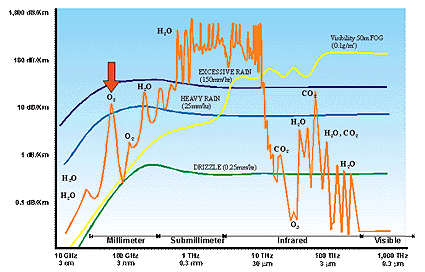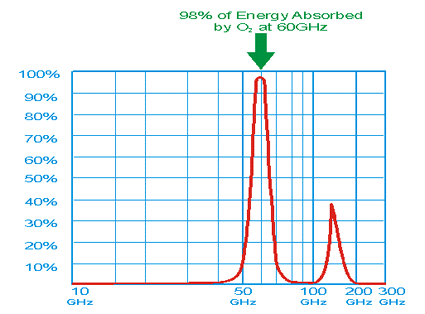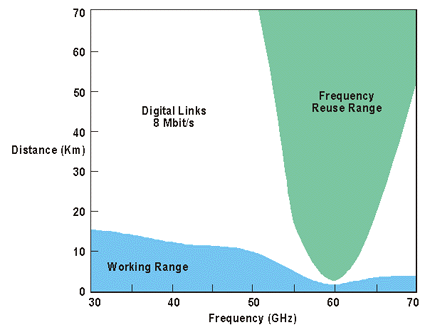5G at 60GHz: Unique Oxygen Absorption Properties

The demand for bandwidth is growing at a rapid pace. International Data Corporation projects that Internet commerce in the United States will grow from $74 billion in 1999 to $708 billion in 2003, with the number of computer users more than doubling from 81 million to 177 million in the U.S. alone. Due to the tremendous expected growth, reliable fiber optic networks must be installed quickly.
In the United States, less than five percent of all commercial office buildings have access to fiber cables. With the high costs to install physical fiber, up to $250,000 per mile, many stopgap techniques, including ISDN, DSL, satellite and microwave communications links, have been deployed to overcome this “last mile” challenge. However, these techniques pose only temporary solutions, as ISDN and DSL require bandwidth from physical mediums that were not designed for Internet use, and available licensed microwave frequencies, 900MHz to 40GHz, and satellite frequencies, 6GHz to 30GHz, are limited.
Short haul, high-density deployments of wireless communications devices are required in metropolitan areas and business parks throughout the United States. Most often, office buildings though not physically linked to the fiber backbone are within one half mile of a local fiber trunk. Wireless communication devices operating at higher frequencies, such as 60GHz, allow businesses to link to the fiber easily, without the cost and time delays associated with physical fiber installation.
Due to the increased bandwidth demands and the scarcity of microwave frequency allocations, the wireless communications industry is beginning to focus on higher, previously unallocated portions of the spectrum in the millimeter wave frequencies from 40GHz to 300GHz. Due to the high levels of atmospheric RF energy absorption, the millimeter wave region of the RF spectrum is not usable in long haul, wireless communications segments. However, for short haul, “last mile” segments, the expanded RF data bandwidth available in the millimeter wave region makes it ideal for interference free, fiber speed connectivity.MORE INFO HERE Breaking: California Supreme Court affirms municipal authority to regulate utilities and right-of-way ‘small cell’ towers
Figure 1 illustrates the atmospheric absorption for millimeter wave frequencies.
At the millimeter wave frequency of 60GHz, the absorption is very high, with 98 percent of the transmitted energy absorbed by atmospheric oxygen. While oxygen absorption at 60GHz severely limits range, it also eliminates interference between same frequency terminals.

The benefit of Oxygen absorption relative to frequency re-use is detailed in figure 2. Figure 2 illustrates the distance relationship between the 60GHz frequency reuse range, the green region, and the traditional range, the blue region. Oxygen absorption makes possible the same-frequency reuse within a very localized region of air space. Operation within the 60GHz millimeter wave spectrum enables very dense interference free deployment of same frequency radio terminals.

A 60GHz communications system must overcome the effects of oxygen absorption, 16dB/KM. In order to operate reliably at even short ranges, a very focused, narrow-beam antenna must also be employed to increase the level of signal available to the target receiver. This combination of oxygen absorption and narrow beam transmission enhances the security of the 60GHz radio link, minimizing the probability of unauthorized intercept.